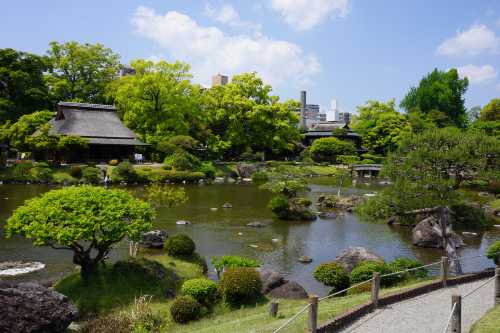Popular Trip Moments
Kumamoto's Hidden Gem - Strolling Along the Kasese River Trail | Kumamoto Suizenji Ezu Lake Park: A Tranquil Time at the Banana Grove and Haiku Monument | Three tranquil spots in Kumamoto Suizenji Jojuen Garden: literary ancient buildings, historical exhibitions, and spring cherry blossom gardens | Kumamoto Suizenji Jojuen Garden - Higo Rokka | Kumamoto Suizenji Temple Jojuen Garden: Elegant time with the Hosokawa River Basin Stone and sacred standing sand | Kumamoto Castle | Kumamoto Suizenji Jojuen Garden: A Place for Cultural Strolls from History to Literature | Grids Premium Hotel, Kumamoto: A modern hotel with convenient transportation and complete facilities, high CP value | Kumamoto Suizenji Jojuen Garden: A Place for Cultural Strolls from Faith to History | 🌿🏯 *Suizenji Jojuen Garden: A Miniature Kyoto in Kumamoto* 🎋🍵 | [Kato Shrine] Go meet the guardian deity of Kumamoto Castle⛩️✨ | [Suizenji Jojuen Garden] A soothing garden in Kumamoto that will put your mind at ease | [Kumamoto Castle] A symbol of Kumamoto that will impress you with its history and strength of recovery🏯✨ | MSC Cruises Japan five-day four-night travel strategy! | Kumamoto Castle in Kyushu, Japan | [One of Japan's Three Greatest Castles] Kumamoto Castle🏯 | Suizenji Jojuen Garden | 🇯🇵Japan Travel🏯Kyushu First Resort Ceiling | ตามล่า One Piece | A Comprehensive Guide to Enjoying Kumamoto Twice as Much: 4 Nights and 5 Days Itinerary! | Suizenji Jojuen Garden (水前寺成趣園) – A Miniature Kyoto in Kumamoto** 🌿🎋 | Majestic Black-and-White Castle Walls and Tower | THE BLOSSOM KUMAMOTO (더 블라썸 구마모토) Moderate Double Room | Suizenji Jojuen Garden in Kumamoto | Kumamoto 2-Day 1-Night Highlights Tour: A Perfect Blend of Culture, Food and Nature! 🏯 | Kumamoto Castle, a must-see in Kumamoto | Sakuramachi Kumamoto | [Japan 🇯🇵] Suizenji Jojuen Koen: A Slice of Edo-Era Serenity in Kumamoto! | 2025 Early April Fukuoka Cherry Blossom Trip | 🏯 Kumamoto Castle — One of the three most famous castles in Japan, built by Kato Kiyomasa
Recommended Attractions at Popular Destinations
Popular Attractions in Bangkok | Popular Attractions in Manila | Popular Attractions in Tokyo | Popular Attractions in Taipei | Popular Attractions in Hong Kong | Popular Attractions in Seoul | Popular Attractions in Kuala Lumpur | Popular Attractions in Los Angeles | Popular Attractions in Shanghai | Popular Attractions in New York | Popular Attractions in Shenzhen | Popular Attractions in Osaka | Popular Attractions in Singapore | Popular Attractions in London | Popular Attractions in Guangzhou | Popular Attractions in San Francisco | Popular Attractions in Beijing | Popular Attractions in Macau | Popular Attractions in Bali | Popular Attractions in Jakarta | Popular Attractions in Paris | Popular Attractions in Ho Chi Minh City | Popular Attractions in Istanbul | Popular Attractions in Phuket | Popular Attractions in Chicago | Popular Attractions in Seattle | Popular Attractions in Toronto | Popular Attractions in Orlando | Popular Attractions in Cebu | Popular Attractions in Chiang Mai
Popular Restaurants in Kumamoto
Buffet Dining Asoshed | fountain | Korin | Katsuretsutei Shinshigai Honten | Umazakura Shimotori | Osteria Da Rubacuore | Gorohachi Honten | Yakinikukan Sairo Shimizuten | Taori | Vegemaki | Kumamoto Ramen KOKUTEI Honten (Main Store) | Korantei Shimotōri | Suganoya Kamitori | Edomaesengoku | Furumachi sen | tokunagakita | cafe & books bibliotheque Kumamoto Tsuruya | Benkay | Sahanji | Aoyagi | Ineya Kumamoto | Kokutei | Umakassai | Ogata | Yakiniku Senshoh | Robiraunji & Bar ANDO Za Nyu Hotel Kumamoto | Sun Cielo | Yokobachi | McDonalds Hakusandori-ten | Tengaiten
Popular Ranked Lists
Popular Premium Hotels in Dong Nai Province | Popular Trending Attractions in Changsha | Popular Premium Hotels in Thanh Hoa Province | Top 10 Trending Attractions in Harbin | Top 10 Luxury Hotels near Apollo Bay | Popular Premium Hotels in Ustka | Top 50 Must-Visit Restaurants in Beijing | Top 50 Must-Visit Restaurants in Bangkok | Popular Premium Hotels in Buenavista del Norte | Top 50 Must-Visit Restaurants in Shenzhen | Top 50 Must-Visit Restaurants in Shanghai | Top 50 Must-Visit Restaurants in Tokyo | Top 50 Must-Visit Restaurants in Nha Trang | Top 50 Must-Visit Restaurants in Florence | Top 20 Trending Attractions in Beijing | Popular Premium Hotels in Memphis | Popular Trending Attractions in Singapore | Popular Premium Hotels in San Lawrenz | Top 50 Must-Visit Restaurants in Bali | Top 50 Must-Visit Restaurants in Seattle | Popular Trending Attractions in Tonglu | Popular Trending Attractions in New York | Top 50 Must-Visit Restaurants in San Francisco | Popular Premium Hotels in Pasadena | Popular Premium Hotels in Davao | Top 50 Must-Visit Restaurants in Xi'an | Popular Premium Hotels in Tottori Prefecture | Top 50 Must-Visit Restaurants in Phuket | Popular Trending Attractions in Chengdu | Popular Luxury Hotels in Al Jazirah Al Hamra
About
Payment Methods
Our Partners
Copyright © 2025 Trip.com Travel Singapore Pte. Ltd. All rights reserved
Site Operator: Trip.com Travel Singapore Pte. Ltd.
Site Operator: Trip.com Travel Singapore Pte. Ltd.
















